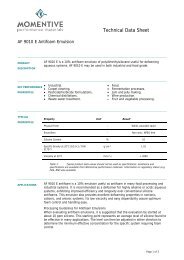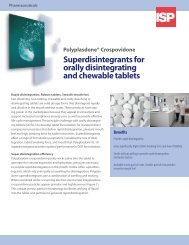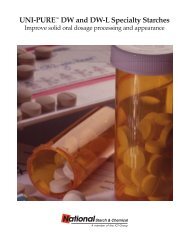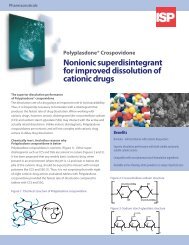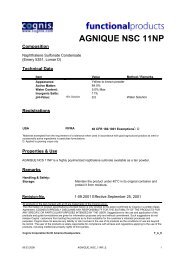Inert Lubricants Oils – Greases – Waxes - Anshul Life Sciences
Inert Lubricants Oils – Greases – Waxes - Anshul Life Sciences
Inert Lubricants Oils – Greases – Waxes - Anshul Life Sciences
You also want an ePaper? Increase the reach of your titles
YUMPU automatically turns print PDFs into web optimized ePapers that Google loves.
Surface Tension<br />
Halocarbon oils have low surface tensions because of their chemical composition. The<br />
low values (23 to 30 dynes/cm) result in easy wetting of most materials, which is helpful<br />
for lubricity and other properties.<br />
Electrical Properties<br />
The typical volume resistivity of Halocarbon oil is in the range of 10 13 to 10 14 ohm-cm.<br />
The dielectric constant varies from 2.25 to 4.0 depending on frequency and temperature.<br />
Thermal Stability<br />
The thermal stability of Halocarbon oils extends up to the decomposition temperature of<br />
the carbon chain. The decomposition to toxic, nonsludge-forming volatiles occurs rapidly<br />
at 327°C (620°F), noticeably at 304°C (580°F) and to a lesser degree at lower temperatures.<br />
The maximum safe operating temperature recommended, therefore, is 204°C (400°F) and<br />
maximum short-term temperature recommended is 260°C (500°F) in scrupulously clean<br />
systems. <strong>Oils</strong> containing rust inhibitor discolor after some exposure to temperatures of<br />
approximately 121°C (250°F) due to decomposition of the inhibitor. The oil is unchanged.<br />
Material Compatibility<br />
Elastomers and Plastics<br />
The major portion of any elastomer is a specific cross-linked polymer, but its properties depend<br />
in large part upon fillers, plasticizers and other additives. In fact, the composition of the final item<br />
such as an O-ring or gasket is usually proprietary. Therefore, predictions about compatibility for<br />
any elastomer must be viewed with caution. A prudent approach would involve bench tests with<br />
the specific elastomer at operating conditions. Keeping these cautions in mind, Halocarbon oils<br />
have been found compatible with specific recipes of the following elastomers:<br />
Ethylene propylene rubber<br />
Polyvinyl alcohol<br />
Neoprene<br />
Polytetrafluoroethylene<br />
(PTFE) and other<br />
fluorinated plastics<br />
Chlorinated polyethylene<br />
Viton ® , Fluorel ®<br />
Kalrez ®<br />
Polyimides<br />
Polycarbonates<br />
Fluorosilicone<br />
Cured epoxies<br />
Urethanes<br />
PNF (phosphonitrilic<br />
fluoroelastomer)<br />
EPDM (ethylene<br />
propylene diene rubber)<br />
back to Contents<br />
12



